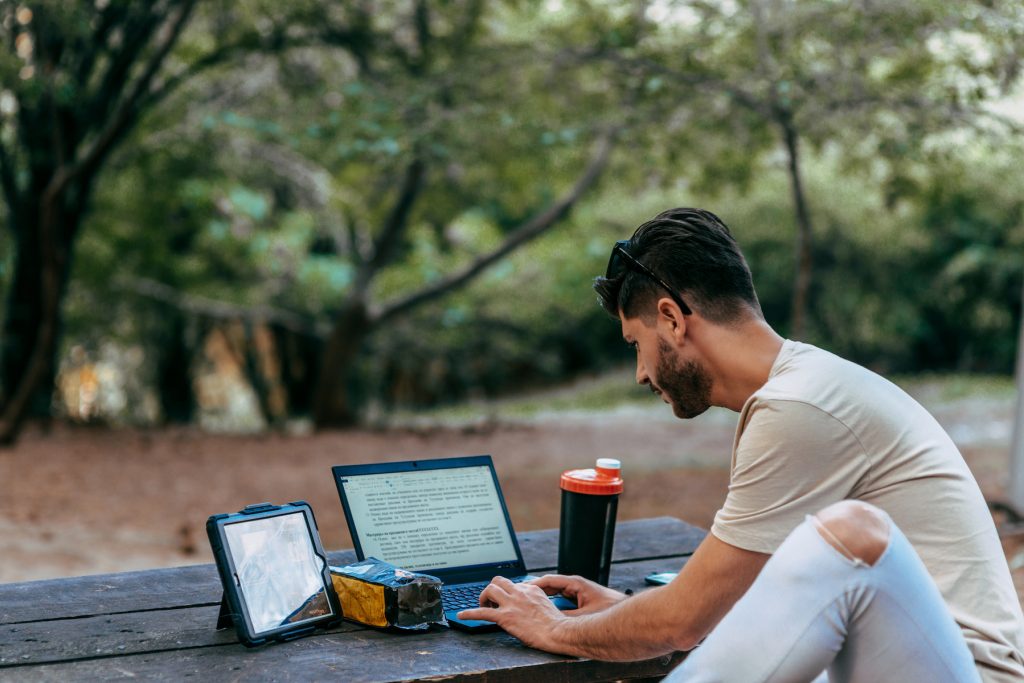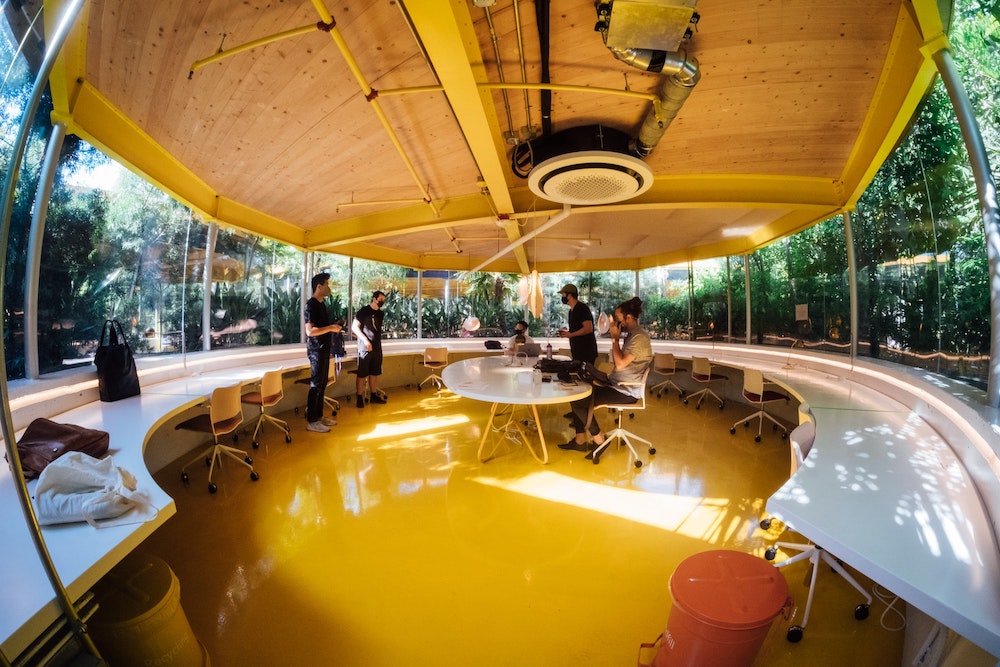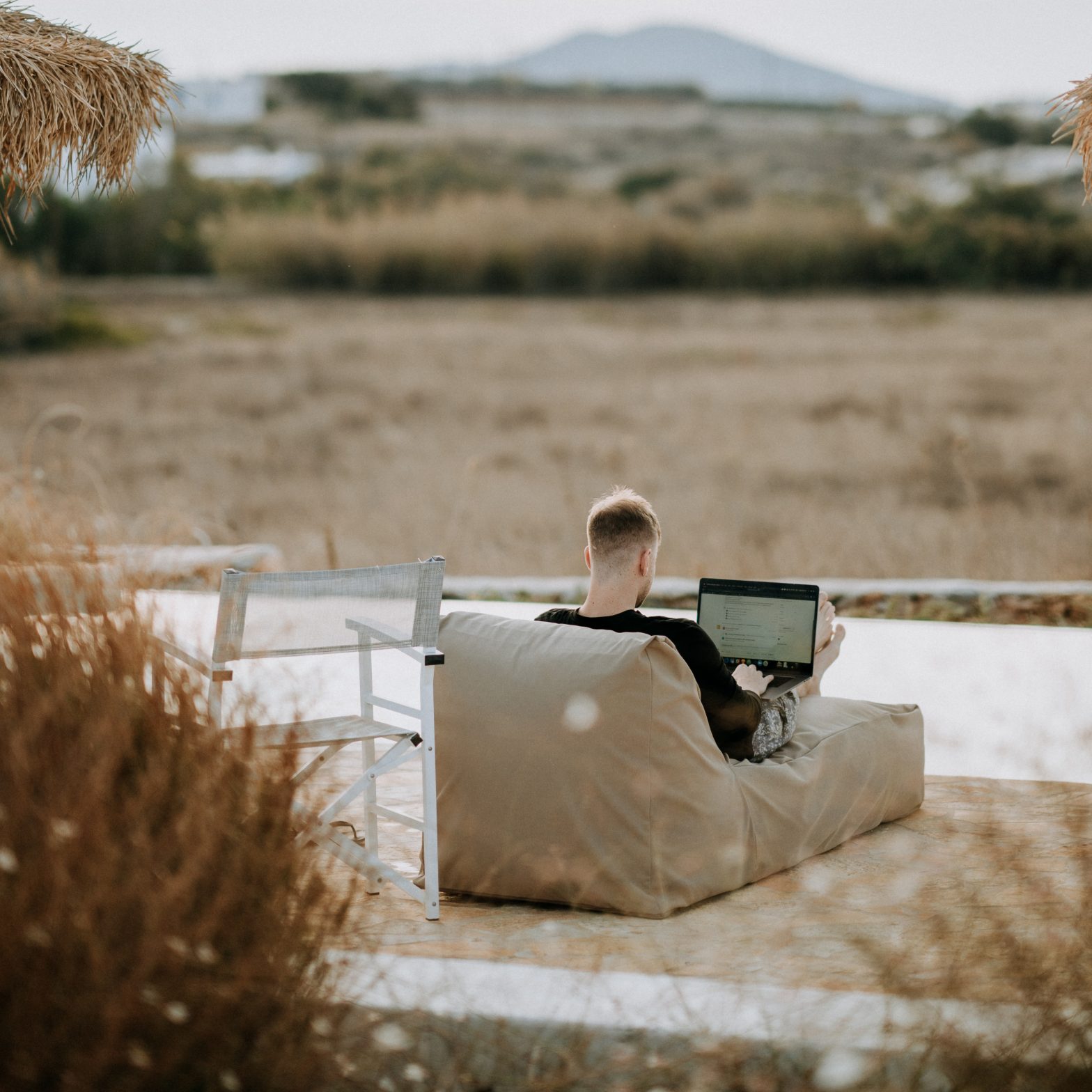Sure, unpredictable weather is a big concern, but the pandemic has sent the demand for fresh air, green spaces, and exterior amenities skyrocketing. ‘Inside out’ design is an intriguing solution.
Imagine a breeze ruffling your hair, birds singing in the background, greenery surrounding your screen, the sun warming your keyboard… The very idea of relocating your desk outside sounds downright idyllic. Half a year into a global pandemic, people have already become comfortable shifting their everyday activities into safer open spaces outdoors. Why not bring along a laptop, too? Unfortunately, practical realities emerge almost instantly to burst this bucolic bubble when you consider the challenges of moving an entire company’s workforce into the great outdoors. What happens when it rains or snows? How do you deal with shifting temperatures? And how might noise from traffic, airplanes, or even birds factor in?
It doesn’t take much imagination to game out this scenario, as one hedge fund is literally a case study in real-time. When their traditional trading floor was deemed too dense in the face of COVID-19, Bridgewater Associates’ Westport, Conn. employees dragged their monitors into a forest so that they could collaborate while safely distanced. That was in May. And they’re still out there. As detailed in Fortune, the firm’s woodsy workspace became a sort of computer-filled camp experience—complete with tented workstations and a dress code that calls for sunscreen. An investment in noise-canceling software quieted the birdsongs during calls and Zoom meetings, but navigating dripping sap and falling trees required some quick in-the-moment thinking. October is expected to be the firm’s last month spent in their outdoor office, but the firm’s leadership noticed that productivity metrics actually increased since the open-air move. They plan to shift team members outside again next summer—even if COVID no longer lingers.
The success of Bridgewater’s outdoor experiment begs the question: Why aren’t more companies doing this?

Spending our workdays stuck within hermetically sealed monolithic buildings was never the healthiest option anyway (a point that’s been well-documented for years). While the last decade of office design green-lit living walls, plant life, terraces and natural light, these assets are primarily considered just beneficial extras. Biophilic beautification takes a fair amount of planning and work, after all. “And typically it’s the first thing to get value-engineered out of a project due to cost, maintenance, or just being deemed not essential,” notes Kate Wieczorek, the manager of workplace strategy for Ted Moudis Associates—a firm that handles architecture, interior design and workplace strategy services for corporate and retail spaces. But that relaxed attitude toward biophilia is rapidly changing. Making the office more like the outdoors—with filtered air and good ventilation will be a major post-pandemic priority.
Office space is traditionally shaped from the inside; now, it’s time to think about “inside out” design. Wieczorek lists shifting weather, uncomfortable temperatures and background noise among the biggest challenges of creating completely al fresco workspaces (as Bridgewater’s experience easily demonstrates). But she believes architectural solutions can and do exist. “Design can solve some of these issues by implementing a system that has a retractable roof or walls, which can be deployed if weather conditions necessitate the need to be inside,” she offers. That’s a key feature likely to top future-focused office wishlists soon, alongside weather-resistant power outlets, ergonomic outdoor furniture and shade elements. Simply designing an outdoor seating option—alongside portable heaters or fans—can help reduce COVID transmission risks, improve air quality, and keep workers comfortable, Wieczorek goes on to say. Other wellness-focused options? Pavilions. Balconies. Windows that open. Walls that retract. Doors that roll up or pocket away. And of course, higher-quality air filtration systems for enclosed rooms. None of these ideas represent a reinvention of the wheel, either. They exist. It’s only a matter of bringing them together with an eye toward health, wellness and safety.
Perhaps the gold standard of existing wellness-oriented outdoor offices is Los Angeles’s recently opened coworking space, Second Home Hollywood. Its radical design may set the bar for outdoor offices, period. The London-based brand’s first U.S. location and sixth site created in partnership with the Madrid-based design firm Selgascano, Second Home Hollywood is a sweep of low-rise, low-density architecture with more than 50% of its campus outdoors. The majority of its workspaces are housed in 60 individual studios tucked within a lush garden. Each “pod” is individually ventilated and includes windows that open. They’re also semi-subterranean by design, with insulation that keeps them temperature-stable. Indoor spaces utilize MERV-13 hospital-grade air filters (aka, actual virus catchers) and desks are made of Corian, a nonporous material used in medical institutions that’s easy to keep hygienic. There are no shared hallways, no elevators, no bottlenecks where you’d involuntarily breathe on or brush against someone else. All that, and Second Home L.A. boasts a wow-worthy office design too: Each greenery-ringed pod features curved, transparent acrylic walls capped by a lemon yellow roof.

What’s even more striking is that this coworking space was conceived and built before the existence of the novel coronavirus. It’s a reclaimed and transformed derelict 1960s building plus a parking lot, and it opened last September. “We can’t claim any premonition on COVID, but our emphasis was on health and on biophilic thinking—it’s the way we’ve always done our spaces,” says Rohan Silva, Second Home’s co-founder and CEO. “In L.A., what we wanted to do was take the office outside into nature, and turn it inside out. So we took a horrible car park and covered it in tons of trees.” This unique design has allowed Second Home Hollywood to continue operating almost without pause even as neighboring office buildings emptied. And interest and inquiries continue to spike. “We certainly wish COVID had never happened, but it has acted as a catalyst and a wakeup call for thinking, ‘Is my workplace actually healthy? Is it conducive to good health, as it could be and should be?’” he asks.
With an increased focus on health and wellbeing permeating all aspects of our lives right now, it’s easier than ever to see that the benefits of biophilia, natural lighting and air quality are essential elements for offices—not extras. A wellness investment is a worthy one, as the next pandemic isn’t a possibility, it’s a probability. And the pay-off is clear. “We can only be as productive as our health allows us to be,” says Wieczorek. “True health and wellness needs to be embedded into workplace culture.”
